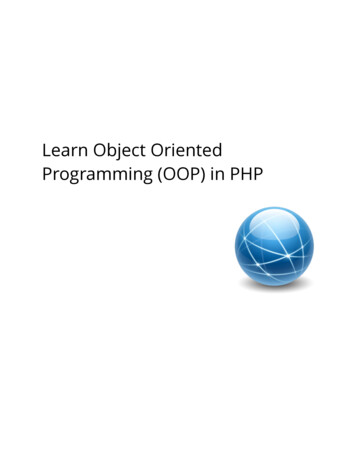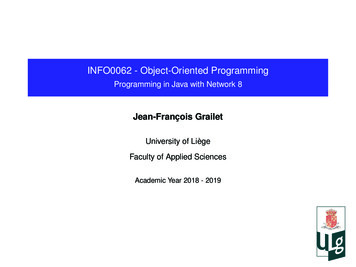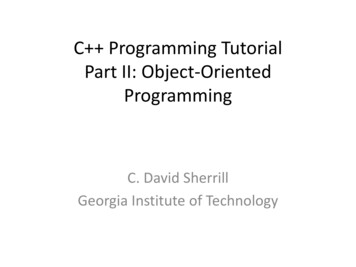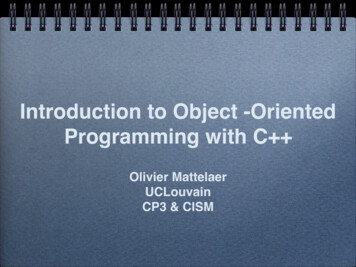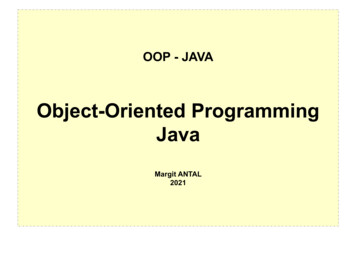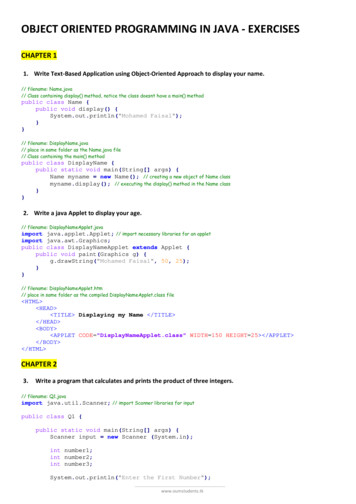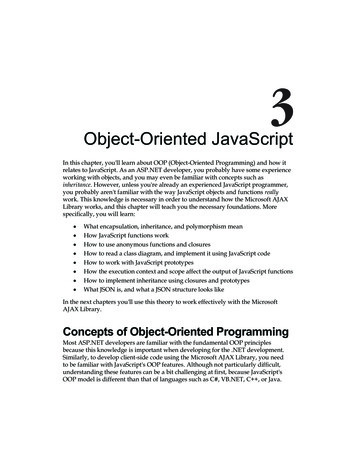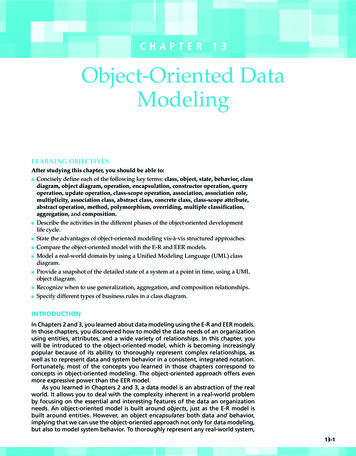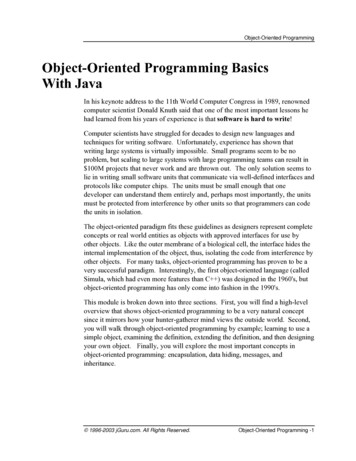
Transcription
Object-Oriented ProgrammingObject-Oriented Programming BasicsWith JavaIn his keynote address to the 11th World Computer Congress in 1989, renownedcomputer scientist Donald Knuth said that one of the most important lessons hehad learned from his years of experience is that software is hard to write!Computer scientists have struggled for decades to design new languages andtechniques for writing software. Unfortunately, experience has shown thatwriting large systems is virtually impossible. Small programs seem to be noproblem, but scaling to large systems with large programming teams can result in 100M projects that never work and are thrown out. The only solution seems tolie in writing small software units that communicate via well-defined interfaces andprotocols like computer chips. The units must be small enough that onedeveloper can understand them entirely and, perhaps most importantly, the unitsmust be protected from interference by other units so that programmers can codethe units in isolation.The object-oriented paradigm fits these guidelines as designers represent completeconcepts or real world entities as objects with approved interfaces for use byother objects. Like the outer membrane of a biological cell, the interface hides theinternal implementation of the object, thus, isolating the code from interference byother objects. For many tasks, object-oriented programming has proven to be avery successful paradigm. Interestingly, the first object-oriented language (calledSimula, which had even more features than C ) was designed in the 1960's, butobject-oriented programming has only come into fashion in the 1990's.This module is broken down into three sections. First, you will find a high-leveloverview that shows object-oriented programming to be a very natural conceptsince it mirrors how your hunter-gatherer mind views the outside world. Second,you will walk through object-oriented programming by example; learning to use asimple object, examining the definition, extending the definition, and then designingyour own object. Finally, you will explore the most important concepts inobject-oriented programming: encapsulation, data hiding, messages, andinheritance. 1996-2003 jGuru.com. All Rights Reserved.Object-Oriented Programming -1
Object-Oriented ProgrammingExecutive SummarySummary Object-oriented programming takes advantage ofour perception of world An object is an encapsulated completely-specifieddata aggregate containing attributes and behavior Data hiding protects the implementation frominterference by other objects and definesapproved interface An object-oriented program is a growing andshrinking collection of objects that interact viamessages You can send the same message to similar objects-the target decides how to implement or respondto a message at run-time Objects with same characteristics are calledinstances of a class Classes are organized into a tree or hierarchy. Two objects are similar if they have the sameancestor somewhere in the class hierarchy You can define new objects as they differ fromexisting objects Benefits of object-oriented programming include: reduced cognitive load (have less to thinkabout and more natural paradigm) isolation of programmers (better teamprogramming) less propagation of errors more adaptable/flexible programsObject-Oriented Programming - 2 1996-2003 jGuru.com. All Rights Reserved.
Object-Oriented Programming faster development due to reuse of codeYou are used to observing the world around you through the eyes of a huntergatherer: mainly animals acting upon other animals and objects. There must havebeen tremendous selection pressure for brains that were adept at reasoning aboutentities, their attributes, their behavior, and the relationships among them. Is thatobject edible, ready to eat me, or going to mate with me? When writing software,one can easily argue that you are at your best when designing and implementingsoftware in a manner that parallels the way your brain perceives the real world.This section attempts to explain and motivate object-oriented design concepts bydrawing parallels to our natural way of thinking.Encapsulation and data hidingThe first and most important design principle we can derive from our perceptionof the real world is called encapsulation. When you look at an animal, youconsider it to be a complete entity--all of its behavior and attributes arise strictlyfrom that animal. It is an independent, completely-specified, and self-sufficientactor in the world. You do not have to look behind a big rock looking for anotherbit of functionality or another creature that is remotely controlling the animal.Closely associated with encapsulation is the idea of data hiding. Most animalshave hidden attributes or functionality that are inaccessible or are only indirectlyaccessible by other animals. The inner construction and mechanism of the humanbody is not usually available to you when conversing with other humans. You canonly interact with human beings through the approved voice-recognition interface.Bookkeeping routines such as those controlled by the autonomic nervous systemlike breathing may not be invoked by other humans. Without bypassing theapproved interface, you cannot directly measure attributes such as internal bodytemperature and so on.One can conclude that we perceive objects in the world as encapsulated (selfcontained) entities with approved interfaces that hide some implementationbehavior and attributes. From a design perspective, this is great because it limitswhat you have to think about at once and makes it much easier for multipleprogrammers to collaborate on a program. You can think about and design eachobject independently as well as force other programmers to interact with yourobjects only in a prescribed manner; that is, using only the approved interface.You do not have to worry about other programmers playing around with the innerworkings of your object and at the same time you can isolate other programmersfrom your internal changes. 1996-2003 jGuru.com. All Rights Reserved.Object-Oriented Programming -3
Object-Oriented ProgrammingEncapsulation and data hiding are allowed to varying degrees in non-objectoriented languages and programmers have used these principles for decades. Forexample, in C, you can group related variables and functions in a single file, makingsome invisible to functions in other files by labeling them as static. Conversely,object-oriented languages support these design principles. In Java, for example,you will use an actual language construct called a class definition to groupvariables and functions. You can use access modifiers like private and public toindicate which class members are visible to functions in other objects.The interaction of objects using polymorphismEncapsulation and data hiding are used to define objects and their interfaces, butwhat about the mechanism by which objects interact? In the real world, animalsare self-contained and, therefore, do not physically share brains. Animals mustcommunicate by sending signals. Animals send signals, depending on the species,by generating sound waves such as a voice, images such as a smile, and chemicalssuch as pheromones. There is no way for an animal to communicate with anotherby directly manipulating the internal organs or brain of another because thosecomponents are hidden within the other animal. Consequently, our brain ishardwired to communicate by sending signals.If we view the world as a collection of objects that send and receive messages,what programming principle can we derive? At first you may suspect that asignal or message is just a function call. Rather than manipulate the internals of anobject, you might call a function that corresponded to the signal you wanted tosend.Unfortunately, function calls are poor analogs to real world messaging for twomain reasons. First, function calls do things backwards. You pass objects tofunctions whereas you send messages to an object. You have to pass objects tofunctions for them to operate on because they are not associated with a particularobject. Second, function calls are unique in that the function's name uniquelyidentifies what code to run whereas messages are more generic. The receiver of amessage determines how to implement it. For example, you can tell a man and awoman both to shave and yet they respond to the exact same message by doingradically different things.The truly powerful idea behind message sending lies in its flexibility--you do noteven need to know what sex the human is to tell them to shave. All you need toknow is that the receiver of the message is human. The notion that similar, butdifferent, objects can respond to the same message is technically calledObject-Oriented Programming - 4 1996-2003 jGuru.com. All Rights Reserved.
Object-Oriented Programmingpolymorphism (literally "multiple-forms"). Polymorphism is often called latebinding because the receiver object binds the message to an appropriateimplementation function (method in Java terminology) at run-time when themessage is sent rather than at compile-time as functions are.Polymorphism's flexibility is derived from not having to change the code thatsends a message when you define new objects. Imagine a manager that signalsemployees when to go home at night. A so-called micro-manager must know allsorts of details about each employee (such as where they live) to get them home atnight. A manager that delegates responsibility well will simply tell each employeeto go home and let them take care of the details. Surely, adding a new kind ofemployee such as a "summer intern" should not force changes in the managercode. Alas, a micro-manager would in fact have to change to handle the details ofthe new employee type, which is exactly what happens in the function-centric,non-object-oriented programming model.Without polymorphism, encapsulation's value is severely diminished because youcannot effectively delegate, that is, you cannot leave all the details within a selfcontained object. You would need to know details of an object to interact with itrather than just the approved communication interface.The relationship between objects and inheritanceHumans rely on their ability to detect similarities between objects to survive newsituations. If an animal has many of the characteristics of a snake, it is best toleave it alone for fear of a venomous bite. In fact, some animals take advantage ofsimilarity detectors in other animals by mimicking more dangerous creatures; somekingsnakes have colored bands like the deadly coral snake, although in a differentorder. Similarly, we learn most easily when shown new topics in terms of howthey relate or differ from our current knowledge base. Our affinity for detectingand using similarity supports two important ideas in the object-oriented designmodel: polymorphism requires a definition of similarity to be meaningful and wecan design new objects as they differ from existing objects.Behavior versus identitySending the same message to two different objects only makes sense when theobjects are similar by some measure. For example, it makes sense to tell a bird andan airplane to fly because they share behavior. On the other hand, telling a dog tosit makes sense, but telling a cat to sit makes no sense; well, it is a waste of timeanyway. Telling a human to shave makes sense, but telling an airplane to shavedoes not. One way to define similarity is to simply say that the objects 1996-2003 jGuru.com. All Rights Reserved.Object-Oriented Programming -5
Object-Oriented Programmingimplement or respond to the same message or set of messages; that is to say, theyshare at least a partial interface (common subset of public methods). This is theapproach of early object-oriented languages such as SmallTalk.Another similarity measure corresponds to the relationship between the objectsthemselves rather than just their interfaces. If two objects are the same kind ofobject then it makes sense that they also share a partial interface. For example,males and females are kinds of humans and, hence, share a common interface(things that all humans can do like shave, sleep, sit and so on). Java uses objectrelationships to support polymorphism.The inheritance relationshipWhat metaphor does Java use to specify object relationships? Java usesinheritance. That is, if man and woman objects are kinds of humans then they aresaid to inherit from human and therefore share the human interface.Consequently, we are able to treat them generically as humans and do not have toworry about their actual type. If we had a list of humans, we could walk downthe list telling everyone to shave without concern for the objects' concrete type(either man or woman). Late-binding ensures that the appropriate method isinvoked in response to the shave message depending on the concrete type at runtime.All objects have exactly one parent, inheriting all of the data and method membersfrom the parent. The inheritance relationships among objects thus form a tree,with a single predefined root called Object representing the generic object.Defining by differenceThe second important feature of an object-oriented design model inspired bysimilarity detection is "defining by difference." If I want to define a new object inmy system, an efficient way to do so is to describe how it differs from an existingobject. Since man and woman objects are very similar, the human objectpresumably contains most of the behavior. The man object, for example, only hasto describe what distinguishes a man from the abstract notion of a human, such asbuying lots of electronic toys.BackgroundImagine a portable, object-oriented (classes, data hiding, inheritance,polymorphism), statically-typed ALGOL-derived language with garbagecollection, threads, lots of support utilities. Thinking about Java or Objective-CObject-Oriented Programming - 6 1996-2003 jGuru.com. All Rights Reserved.
Object-Oriented Programmingor C ? Actually, the description fits Simula67 as in 1967--over thirty yearsago. The complete object-oriented mechanism found in Java has been around along time and there have been many languages developed between Simula67 andJava.Excerpt from The History of Simulaby Jan Rune Holmevik, jan@utri.no /jag/SimulaHistory.htmlThe SIMULA programming language was designed and built byOle-Johan Dahl and Kristen Nygaard at the Norwegian ComputingCentre (NCC) in Oslo between 1962 and 1967. It was originallydesigned and implemented as a language for discrete eventsimulation, but was later expanded and reimplemented as a fullscale general purpose programming language. Although SIMULAnever became widely used, the language has been highly influentialon modern programming methodology. Among other thingsSIMULA introduced important object-oriented programmingconcepts like classes and objects, inheritance, and dynamic binding.Over the past 40 years, four main computation paradigms have developed: Imperative (procedural); C, Pascal, Fortran Functional; Lisp, ML Logic (declarative); Prolog Object-oriented; Simula67, SmallTalk, CLOS, Objective-C, Eiffel, C , JavaThere are also application-specific languages like SQL, SETL (set language),AWK/PERL, XML (structured data description), ANTLR (grammars),PostScript, and so on. The idea is that you should use the "right tool for the rightjob."Object-oriented programming is not a "silver bullet" that should be used in everysituation, but many modern programming problems are readily mapped to objectoriented languages. 1996-2003 jGuru.com. All Rights Reserved.Object-Oriented Programming -7
Object-Oriented ProgrammingObject-Oriented Programming By ExampleThis section is a starting point for learning object-oriented programming. Itparallels the process you would follow to become a car designer: first you learn todrive a car, then you look under the hood, next you learn to modify and repairengines, finally you design new cars. Specifically, in this section, you will:1. learn how to use a trivial object2. study the object definition3. learn to modify an object definition4. learn how to define new objects"Learning to drive"We all know how to add two numbers, for example "3 4 7". In a programminglanguage such as C, you might have the values in variables like this:int a,b,c;a 3;b 4;c a b; // c is 7Now imagine that you plan on doing some graphics work and your basic unit willbe a two-dimensional point not a single number. Languages do not have built indefinitions of point, so you have to represent points as objects (similar to structsin C and records in Pascal). The plus operator " " also is not defined for point soyou must use a method call to add points together. In the following codefragment, type Point holds x and y coordinates and knows how to add anotherpoint to itself yielding another Point. Just like in C or other procedurallanguages, you have to define the type of your variables. Here, the variables areobjects of type Point. To create a new point, use the new operator and specifythe coordinates in parentheses like a function call.Point a, b, c;a new Point(2,4);b new Point(3,5);To add two points together, use the plus() method:c a.plus(b); // c is 5,9In object-oriented terminology, you would interpret this literally as, "send themessage plus to point a with an argument of b." In other words, tell a to add b toObject-Oriented Programming - 8 1996-2003 jGuru.com. All Rights Reserved.
Object-Oriented Programmingitself, yielding a new point. The field access operator, "dot", is used for methodsjust like you use it in C or Pascal to access struct or record fields.A comment about object-oriented method call syntaxThe object-oriented syntaxtarget.method(arguments);may look a bit odd (backwards) since you are used to calling functions notinvoking methods on objects; functions are called with both operands asarguments:c plus(a,b);On the contrary, object-oriented syntax is closer to mathematics and Englishsyntax where the "operator" appears in the middle of the statement. For example,you say "Robot, move left 3 units":robot.moveLeft(3); /* Java style */not "Move left Robot, 3":moveLeft(robot,3); /* C style */The "dot" field access operator is consistent with field access. For example, inmost procedural languages like C, you say p.x to get field x from struct or recordp. As you will see, in object-oriented languages, you group methods as well asdata into objects--the field access operator is consistently used for both.The Point type is called a class because it represents a template for a class ofobjects. In the example above, a, b, and c are all point objects and, hence, they areinstances of class Point. You can think of a class as blueprints for a housewhereas instances are actual houses made from those blueprints. Instances existonly at run-time and an object-oriented program is just a bunch of object instancessending messages to each other. Also, when you hear someone talking about themethods of an object, they are, strictly speaking, referring to the methods definedin the object's class definition."Looking under the hood"Imagine that you wanted to duplicate the simple point addition example above,but in a procedural programming language. You almost certainly would make adata aggregate such as the following C struct: 1996-2003 jGuru.com. All Rights Reserved.Object-Oriented Programming -9
Object-Oriented Programmingstruct Point {int x, y;};Then, to define two points, you would do:struct Point a {2,4};struct Point b {3,5};struct Point c;Adding two points together would mean that you need an add points functionthat returned the point sum like this:c plus points(a,b);A Comment on C syntaxVariable definitions in C are like Java and of the form:type name;ortype name init-value;For example,int x 0;defines an integer called x and initializes it to 0.C data aggregates are called structs and have the form:struct Name {data-field(s);};Defining a variable of struct type allocates memory space to hold something thatbig; specifically, sizeof(Name), in C terminology. You can initialize these structvariables using a curly-brace-enclosed list of values. For example,struct Point a {1,2};makes memory space to hold a point of size sizeof(Point) (normally two 32bit words) and initializes its x and y values to 1 and 2, respectively.To access the fields within a struct, use the "dot" operator. For example, if youprinted out the value of a.x after you defined variable a as above, you would seethe value 1.Object-Oriented Programming - 10 1996-2003 jGuru.com. All Rights Reserved.
Object-Oriented Programmingprinted out the value of a.x after you defined variable a as above, you would seethe value 1.Functions in C are defined as follows:return-type name(arguments){statement(s);}For example, here is a function that adds two integers and returns the result:int add ints(int i, int j){return i j;}Functions with no return type (that is, procedures) use type void:void foo() {.}You could define plus points as follows.struct Point plus points(struct Point a, struct Point b){struct Point result {a.x b.x, a.y b.y};return result;}At this point, you have the data defined for a point and a function to operate onit. How does someone reading your code know that function plus points isused to manipulate points? That person would have to look at the name,arguments, and statements to decide the function's relevance to the Point struct.Invert the question. Where is all the code that manipulates a point? The badnews, of course, is that you have to search the entire program!Object-oriented programming offers a better solution. If humans naturally see theelements in the real world as self-contained objects, why not program the sameway? If you move the functions that manipulate a data aggregate physically intothe definition of that aggregate, you have encapsulated all functionality and stateinto single program entity called a class. Anybody that wants to examineeverything to do with a point, for example, just has to look in a single place. Hereis a starting version of class Point in Java:class Point {int x,y;Point plus(Point p) { 1996-2003 jGuru.com. All Rights Reserved.Object-Oriented Programming -11
Object-Oriented Programming}}return new Point(x p.x,y p.y);It contains both the state and behavior (data and functionality) of Point. Thesyntax is very similar to the C version, except for the method hanging aroundinside. Notice that the name of function plus points becomes method plus;since plus is inside Point, the " points" is redundant. The difference between afunction and a method will be explored in more detail in the section onpolymorphism. For now, it is sufficient to say that C functions or Pascalprocedures become methods inside class definitions.How are objects initialized? In other words, how do the arguments of "newPoint(1,2)" get stored in the x and y fields? In an object-oriented language, youcan define a constructor method that sets the class data members according to theconstructor arguments (arriving from the new expression). The constructor takesthe form of another method with the same name as the class definition and noreturn type. For example, here is an augmented version of Point containing aconstructor.class Point {int x,y;Point(int i, int j) {x i;y j;}Point plus(Point p) {return new Point(x p.x,y p.y);}}The constructor is called by the Java virtual machine once memory space has beenallocated for a Point instance during the new operation.What would happen if you defined the constructor with arguments named thesame thing as the instance variables:Point(int x, int y) {x x;y y;}Ooops. Reference to variables x and y are now ambiguous because you couldmean the parameter or the instance variable. Java resolves x to the closestdefinition, in this case the parameter. You must use a scope override to make thisconstructor work properly:Object-Oriented Programming - 12 1996-2003 jGuru.com. All Rights Reserved.
Object-Oriented ProgrammingPoint(int x, int y) {this.x x; // set this object's x to parameter xthis.y y;}This class definition is now adequate to initialize and add points as in thefollowing fragment.Point a new Point(2,4);Point b new Point(3,5);Point c a.plus(b); // c is 5,9Look at the method invocation:c a.plus(b);What is this really doing and what is the difference between it andc d.plus(b);for some other point, d? You are supposed to think of a.plus(b)as telling a toadd b to itself and return the result. The difference between the two methodinvocations is the target object, but how does method plus know about thistarget; that is, how does plus know which object to add b to--there is only oneargument to the method? Remember that computers cannot "tell" objects to dothings, computers only know (in hardware) how to call subroutines and passarguments. It turns out that the two plus invocations are actually implemented asfollows by the computer:c plus(a,b);c plus(d,b);where the method targets a and d are moved to arguments, thus, converting themfrom message sends to function calls. Because you may have many objects with amethod called plus such as Point3D, the compiler will actually convert yourmethod named plus to a unique function name, perhaps Point plus. Themethod could be converted to a function something like:Point Point plus(Point this, Point p) {return new Point(this.x p.x,this.y p.y);}The "this" argument will be the target object referenced in the method invocationexpression as the translation above implies.So, for the moment, you can imagine that the compiler converts the classdefinition, variable definitions, and method invocations into something very muchlike what you would do in C or other procedural languages. The main difference at 1996-2003 jGuru.com. All Rights Reserved.Object-Oriented Programming -13
Object-Oriented Programmingthis point is that the class definition encapsulates the data of and the functions fora point into a single unit whereas C leaves the data and functions as disconnectedprogram elements.Encapsulation promotes team programming efforts because each programmer canwork on an object without worrying that someone else will interfere with thefunctionality of that object. A related concept enhances the sense of isolation.Data hiding allows you to specify which parts of your object are visible to theoutside world. The set of visible methods provides the "user interface" for yourclass, letting everyone know how you want them to interact with that object.Sometimes helper methods and usually your data members are hidden fromothers. For example, you can modify class Point to specify visibility with a fewJava keywords:class Point {protected int x,y;public Point(int i, int j) {x i;y j;}}public Point plus(Point p) {return new Point(x p.x,y p.y);}The data is protected from manipulation, but the constructor and plus() methodmust be publicly visible for other objects to construct and add points."Modifying the engine"You know how to use objects and what class definitions look like. The next stepis to augment a class definition with additional functionality. To illustrate this,consider how you would print out a point. To print strings to standard output inJava, you call method System.out.println(). You would like to say:System.out.println(p);for some point p. Java has a convention that objects are automatically convertedto strings via the toString() method, therefore, the above statement isinterpreted as:System.out.println(p.toString());Naturally, the functionality for converting a Point to a string will be in classPoint:Object-Oriented Programming - 14 1996-2003 jGuru.com. All Rights Reserved.
Object-Oriented Programmingclass Point {Point(int i, int j) {x i;y j;}Point plus(Point p) {return new Point(x p.x,y p.y);}String toString() {return "(" x "," y ")";}}"Designing new cars"Once you have decided upon a set of objects and their state/behavior in yourdesign, defining the Java classes is relatively straightforward.CompositionConsider defining a Rectangle object composed of an upper left corner and alower right corner. The data portion of Rectangle is pretty simple:class Rectangle {Point ul;Point lr;}What should the constructor for Rectangle look like? Well, how do you want toconstruct them? Construction should look something like:Rectangle r new Rectangle(10,10, 20,40); // size 10x30orPoint p new Point(10,10);Point q new Point(20,40);Rectangle r new Rectangle(p,q); // size 10x30The first Rectangle construction statement uses a constructor that takes the fourcoordinates for the upper left and lower right coordinates:public Rectangle(int ulx, int uly, int lrx, int lry) {ul new Point(ulx,uly);lr new Point(lrx,lry);}The second constructor takes two points:public Rectangle(Point ul, Point lr) { 1996-2003 jGuru.com. All Rights Reserved.Object-Oriented Programming -15
Object-Oriented Programming}this.ul ul;this.lr lr;If your design calls for a method to return the width and height of a Rectangle,you could define method, say getDimensions(), as follows.class Rectangle {protected Point ul;protected Point lr;}/** Return width and height */public Dimension getDimensions() {return new Dimension(lr.x-ul.x, lr.y-ul.y);}Because Java does not allow multiple return values, you must encapsulate thewidth and height into an object, called Dimension as returned bygetDimensions() in the example:class Dimension {public int width, height;}public void Dimension(int w, int h) {width w;height h;}The complete Rectangle class looks like:class Rectangle {protected Point ul;protected Point lr;/** Return width and height */public Dimension getDimensions() {return new Dimension(lr.x-ul.x, lr.y-ul.y);}public Rectangle(int ulx, int uly, int lrx, int lry) {ul new Point(ulx,uly);lr new Point(lrx,lry);}}public Rectangle(Point ul, Point lr) {this.ul ul;this.
With Java In his keynote address to the 11th World Computer Congress in 1989, renowned computer scientist Donald Knuth said that one of the most important lessons he had learned from his years of experience is that software is hard to write! Computer scientists have struggled for decades to


